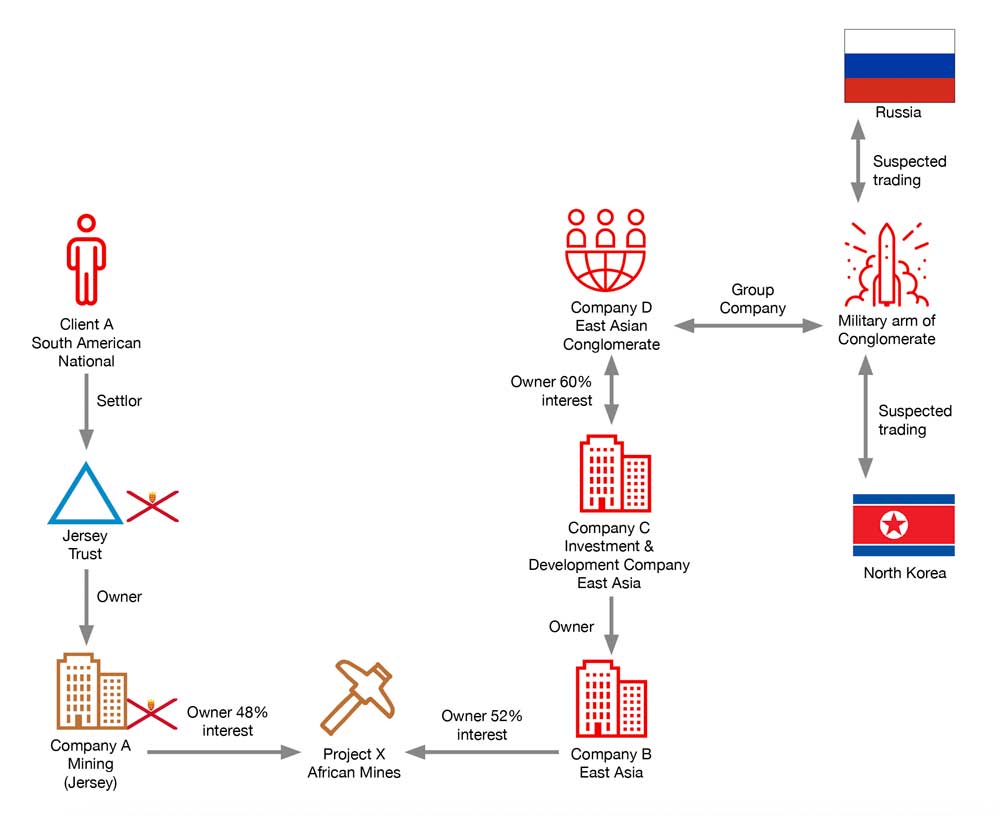A Trust and Company Service Provider (TCSP) provided registered office and secretary services to a UK registered entity, which owned a 58% shareholding in a Jersey registered company (Company A), a holding company involved in mining and exploration projects for gold and other precious metals, primarily located in a sanctioned and designated high-risk country in Africa. This country also has links to bribery & corruption according to the Transparency International corruption index1. The structure was settled by a South American national. The other 42% is held by several small shareholders (employees) and two Politically Exposed Persons (PEPs)2 as identified by the TCSP on the shareholder register.
The purpose of the Trust and Company incorporation in Jersey, was for the establishment of a tax efficient offshore holding entity to manage the underlying mining operations in the African jurisdiction. Due to the company becoming dormant and lack of up-to-date Customer Due Diligence (CDD) and difficulty obtaining any further clarification from the beneficial owner, a decision was made by the TCSP to off-board the client and the company was struck off. There were no assets held in Jersey.
Company A then had no service provider and as the trustees were based outside of Jersey and for the company to be re-domiciled, the company sought another Jersey regulated TCSP to assist with moving the structure abroad. As a result, red flags were identified by the onboarding TCSP.
One of the mining operations, Project X, had a joint investor, Company B who held 51% ownership, it was based and registered in East Asia. An Investment and Development limited company (registered in East Asia) Company C owned this. Within the structure, this was 60% owned by another company in East Asia, Company D, which was part of a state-owned East Asian conglomerate with multiple companies under its umbrella.
CDD by the new TCSP highlighted open-source information, which identified Company D as sanctioned for its proliferation of defence technology to states of concern, the Democratic People’s Republic of Korea (DPRK), and Syria. It had transferred equipment and technology, also known as dual use goods3, that could materially contribute to a weapons of mass destruction or cruise or ballistic missile program to or from these states of concern4.

1 https://www.transparency.org/en/cpi/2024
2 https://www.fatf-gafi.org/content/fatf-gafi/en/publications/Fatfrecommendations/Peps-r12-r22.html
6 https://www.jerseyfsc.org/media/6927/pol-sound-business-practice-policy.pdf
8 https://www.jerseyfsc.org/media/3389/legal-part-1-section-7-enhanced-and-simplified-cdd-measures.pdf
PF refers to the provision of funds or resources to support the development, production, or acquisition of weapons of mass destruction (WMD), including nuclear, chemical, and biological weapons. This type of financing can occur through various means, such as legal or illegal financial transactions, support from state or non-state actors, and the exploitation of financial systems to disguise the true purpose of the funds.
Proliferation financing poses significant threats to global security, as it enables states or organisations to advance their capacities to develop harmful weaponry that can be used for aggression against other nations or in terrorist activities. To combat this threat, many countries and international organizations implement strict regulations and monitoring systems designed to prevent and disrupt the flow of funds intended for proliferation purposes. This includes measures such as enhanced due diligence by financial institutions and stricter compliance with anti-money laundering (AML) and counter-terrorism financing (CTF) policies.
We continually strive to enhance the quality of the products we produce, from our typologies to reports, Insight papers to training guides. However, we can only improve if you share your feedback with us about what you think about them. This is your chance to let us know and we appreciate it your feedback. Click the navy button below or scan the QR code.
Tell us what you think >.svg)